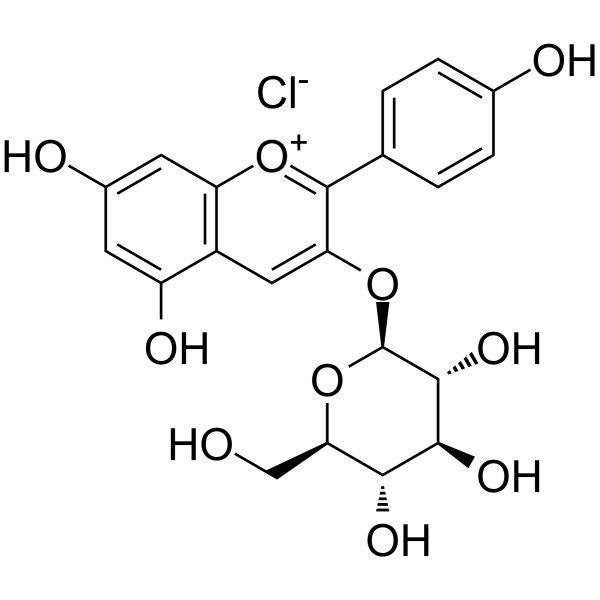氯化天竺葵素-3-O-葡萄糖苷

氯化天竺葵素-3-O-葡萄糖苷结构式

|
常用名 | 氯化天竺葵素-3-O-葡萄糖苷 | 英文名 | Pelargonidin-3-O-glucoside chloride |
|---|---|---|---|---|
| CAS号 | 18466-51-8 | 分子量 | 468.83800 | |
| 密度 | N/A | 沸点 | N/A | |
| 分子式 | C21H21ClO10 | 熔点 | N/A | |
| MSDS | 中文版 美版 | 闪点 | N/A |
|
Inhibitory effects of anthocyanins on secretion of Helicobacter pylori CagA and VacA toxins.
Int. J. Med. Sci. 9(10) , 838-42, (2012) Anthocyanins have been studied as potential antimicrobial agents against Helicobacter pylori. We investigated whether the biosynthesis and secretion of cytotoxin-associated protein A (CagA) and vacuolating cytotoxin A (VacA) could be suppressed by anthocyanin... |
|
|
Urinary excretion of strawberry anthocyanins is dose dependent for physiological oral doses of fresh fruit.
Mol. Nutr. Food. Res. 52(10) , 1097-105, (2008) There is considerable interest in coloured fruits and berries as sources of biologically active anthocyanins. To examine the relationship between the oral dose and the amount excreted for anthocyanins from a food source across a physiological range of doses, ... |
|
|
Strawberry anthocyanin and its association with postprandial inflammation and insulin.
Br. J. Nutr. 106(6) , 913-22, (2011) The present study investigates the effect of strawberry antioxidants in beverage form on meal-induced postprandial inflammatory and insulin responses in human subjects. Overweight adults (n 24) consumed a high-carbohydrate, moderate-fat meal (HCFM) accompanie... |
|
|
Bioavailability of pelargonidin-3-O-glucoside and its metabolites in humans following the ingestion of strawberries with and without cream.
J. Agric. Food Chem. 56(3) , 713-9, (2008) Plasma and urine were collected over a 24 h period after the consumption by humans of 200 g of strawberries, containing 222 micromol of pelargonidin-3- O-glucoside, with and without cream. The main metabolite, a pelargonidin- O-glucuronide, reached a peak pla... |
|
|
Anthocyanin from strawberry (Fragaria ananassa) with the novel aglycone, 5-carboxypyranopelargonidin.
Phytochemistry 65(4) , 405-10, (2004) An anthocyanin, 1, with the novel 4-substituted aglycone, 5-carboxypyranopelargonidin, was isolated in small amounts from the acidified, methanolic extract of strawberries, Fragaria ananassa Duch., by preparative HPLC after purification by partition against e... |
|
|
Anthocyanin-derived phenolic acids form glucuronides following simulated gastrointestinal digestion and microsomal glucuronidation.
Mol. Nutr. Food. Res. 55(3) , 378-86, (2011) Current research indicates that anthocyanins are primarily degraded to form phenolic acid products. However, no studies have yet demonstrated the metabolic conjugation of these anthocyanin-derived phenolic acids in humans.Within the present study, a simulated... |
|
|
Dietary anthocyanins protect endothelial cells against peroxynitrite-induced mitochondrial apoptosis pathway and Bax nuclear translocation: an in vitro approach.
Apoptosis 16(10) , 976-89, (2011) Anthocyanins have received increasing attention because of their relatively high intake in humans and wide range of potential health-promoting effects, including anti-atherogenic properties. Evidences support their vascular protective effects but the involved... |
|
|
Strawberry pelargonidin glycosides are excreted in urine as intact glycosides and glucuronidated pelargonidin derivatives in rats.
Br. J. Nutr. 98(6) , 1126-31, (2007) Anthocyanins are natural dietary pigments with a wide array of biological properties that are possibly involved in the prevention of various diseases. These properties depend on their absorption and metabolism in the body. In the present study we first examin... |
|
|
Neuroprotective effects of anthocyanins on apoptosis induced by mitochondrial oxidative stress.
Nutr. Neurosci. 14 , 249-259, (2011) Mitochondrial oxidative stress (MOS) is a major factor in the underlying pathology of many neurodegenerative diseases. Here, we investigated the neuroprotective effects of a unique class of nutraceutical antioxidants, anthocyanins, against MOS-induced death o... |
|
|
Interaction of selected anthocyanins with erythrocytes and liposome membranes.
Cell Mol. Biol. Lett. 17(2) , 289-308, (2012) Anthocyanins are one of the main flavonoid groups. They are responsible for, e.g., the color of plants and have antioxidant features and a wide spectrum of medical activity. The subject of the study was the following compounds that belong to the anthocyanins ... |